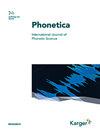西班牙语词头单辅音和集群辅音的时间特征
IF 1.1
3区 文学
Q3 ACOUSTICS
引用次数: 6
摘要
摘要:我们使用发音(电磁发音测量)和声学数据研究了6名标准半岛西班牙语使用者的C1C2 (C1停止、C2横向或轻敲)单词初始聚类的手势协调。我们报告了声音开始时间(VOT)的模式,C1, C2的手势平台持续时间,以及它们的重叠。对于VOT,正如预期的那样,发音位置是主要因素,面膜比唇部表现出更长的VOT。在C1平台持续时间方面,语音和位置效应发现,浊音明显短于清音,舌尖比阴唇持续时间更长。对于C2平台持续时间,发现横向持续时间作为发病复杂性的函数而变化(C vs. CC)。至于重叠,与法语不同,在法语中,群集的发音数据也被研究过,C1和C2都发声的群集比发声不同的群集显示出更多的重叠。此外,重叠受到C2的影响,使得C2为龙头的集群比C2为外侧的集群显示出更少的重叠。我们在工作的背景下讨论这些结果,旨在揭示语音(例如,发音或感知)和语音力量(例如,音节组织)对时间的影响。本文章由计算机程序翻译,如有差异,请以英文原文为准。
Temporal Aspects of Word Initial Single Consonants and Consonants in Clusters in Spanish
Abstract We examined gestural coordination in C1C2 (C1 stop, C2 lateral or tap) word initial clusters using articulatory (electromagnetic articulometry) and acoustic data from six speakers of Standard Peninsular Spanish. We report on patterns of voice onset time (VOT), gestural plateau duration of C1, C2, and their overlap. For VOT, as expected, place of articulation is a major factor, with velars exhibiting longer VOTs than labials. Regarding C1 plateau duration, voice and place effects were found such that voiced consonants are significantly shorter than voiceless consonants, and velars show longer duration than labials. For C2 plateau duration, lateral duration was found to vary as a function of onset complexity (C vs. CC). As for overlap, unlike in French, where articulatory data for clusters have also been examined, clusters where both C1 and C2 are voiced show more overlap than where voicing differs. Further, overlap was affected by the C2 such that clusters where C2 is a tap show less overlap than clusters where C2 is a lateral. We discuss these results in the context of work aiming to uncover phonetic (e.g., articulatory or perceptual) and phonological forces (e.g., syllabic organization) on timing.
求助全文
通过发布文献求助,成功后即可免费获取论文全文。
去求助
来源期刊

Phonetica
物理-声学
CiteScore
1.90
自引率
0.00%
发文量
15
审稿时长
>12 weeks
期刊介绍:
Contemporary research into spoken language employs a wide range of approaches, from instrumental measures to perceptual and neurocognitive measures, to computational models, for investigating the properties and principles of speech in communicative settings across the world’s languages. ''Phonetica'' is an international interdisciplinary forum for phonetic science that covers all aspects of the subject matter, from phonetic and phonological descriptions of segments and prosodies to speech physiology, articulation, acoustics, perception, acquisition, and phonetic variation and change. ''Phonetica'' thus provides a platform for a comprehensive understanding of speaker-hearer interaction across languages and dialects, and of learning contexts throughout the lifespan. Papers published in this journal report expert original work that deals both with theoretical issues and with new empirical data, as well as with innovative methods and applications that will help to advance the field.
 求助内容:
求助内容: 应助结果提醒方式:
应助结果提醒方式:


